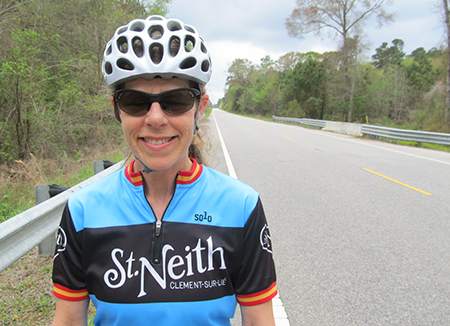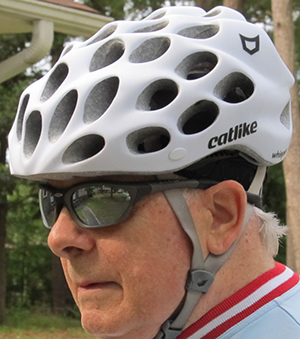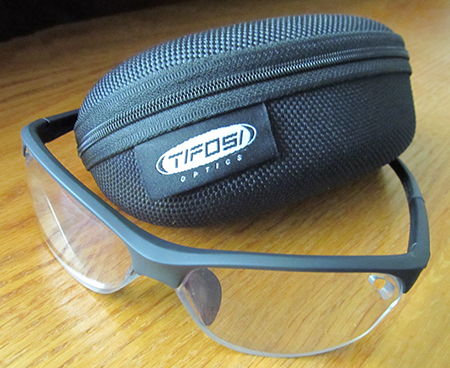Cycling Specific Prescription Eyewear
 Thu, April 20, 2017
Thu, April 20, 2017 
It is hard to believe it has been almost three years since I first ordered my own prescription sunglasses back in June of 2014. (Pictured below right.) Later that year I ordered a pair of clear, no tint lenses that were interchangeable in the same frames. I was then covered for both bright sunlight and low light conditions.
 Fortunately my prescription has not changed and the glasses still serve me well.
Fortunately my prescription has not changed and the glasses still serve me well.
Recently my wife Kathy was in need of a pair of prescription sunglasses, and once again we went to Sport RX, a San Diego based company that specializes in sports eyewear.
As before, I initially emailed then spoke with Rob Tavakoli on the phone, and he was most helpful in guiding me through the many choices. Price was a consideration, but so too was quality. Rob steered me on to the Tifosi brand.
We are all familiar with the big brand names in sunglasses, and Sport RX stocks them all, but Tifosi is an American brand, that doesn’t even try to match the big names with an army of reps on the road, and a huge advertising budget. Rather they concentrate on producing a quality product at a competitive price.
I could relate absolutely to this strategy, it was how I ran my bike business. I didn’t have tens of thousands of dollars to spend on advertising, so instead produced a quality product, and relied on a dealer network to educate the consumer, and sell it. When all is said and done, the huge advertising budget is ultimately paid for by the consumer, with the higher prices you pay for the big brand names.
This time we went with Transitions Xtra Active adaptive lenses. The kind that adjust automatically, and darken or lighten according to the lighting condition. Added to this was Sport RX own anti-glare coating. At nighttime the lenses are almost clear, making them ideal for riding in the dark, or for that matter they can double as night driving glasses, as they cut down on glare.
In bright sunlight they darken quite rapidly, within a few minutes. On some of our rides, there are old growth trees that completely cover the road like a shaded tunnel. Again the lenses adapt to a lighter shade to accommodate this.
The lenses, like my own, are fully progressive, with distance vision in the top portion, and the close up prescription at the bottom. When riding leaning forward, you are looking through the top (Distance.) portion anyway, and having the close up option, it is there if you need to read something, or make adjustments on the bike. It saves having to carry a separate pair of reading glasses.

Above: The Tifosi "Wasp" glasses come in a nice semi-hard case with a zippered closure. This picture illustrates how the Transitions lenses are almost clear straight out of the case. Included with the frames but not shown in this picture, are non-prescription clear and tinted lenses.
As I started out saying, after three years of using my own prescription riding glasses, I can highly recommend them. The curved frames and lenses, fit close to the face so keep out the glare. The curved lenses also make it easier to see sideways, and when turning the head to look behind. They also stay in place on your face, and don’t slip down your nose like regular glasses do.
They are really part of your essential equipment, along with the shoes, shorts, gloves and helmet. Not only from the safety aspect, but proper cycling specific sunglasses make your riding experience just that much more pleasurable.
I highly reccommend Spot RX. They go out of their way to find a product that best suits the individual customer. They understand cyclists and the cyclist's needs. This is the third time I have done business with them and I have never been disapointed. Please mention this blog, because it can't hurt.






































The Grey Escape
The Grey Escape is a charming little documentary film about a group of volunteer cyclists delivering bicycle rickshaws from Denmark to neighboring Norway. They take with them as passengers, a group of elderly residents from a Danish retirement community.
The 250 km. journey started in Rende, Denmark, and covering around 50 or 60 km. per day, the group traveled north to Hirtshals, where they took the ferry to Norway. There the bikes were handed over to the local municipality of Arendal, where they will be used for trips with retirement home residents there.
Coming from Denmark, these elderly passengers had been cyclists all their life, so a trip like this must have brought back many happy memories. To once again feel the wind in their face. It was mentioned in the movie that cycling is to Danes what skiing is to Norwegians.
In one part of the film a commentator says, “They’ve cycled all their lives, and now they can’t do it anymore.” I wondered why? If someone has ridden a bike all their life, they must have a certain level of fitness. They don’t suddenly become disabled overnight.
In a country like Denmark, where cycling is the normal way people get around, I would have thought there would be a number of the elderly who still ride bikes. The only reason to stop is when a person can no longer stay upright, their eyesight fails, or they are too weak to turn the pedals.
The movie touched on a subject that is constantly in my own thoughts, especially when some of these retirees were close to my own age. This is a generation who grew up in the same period I did, and at least in Denmark they maintained a certain level of fitness through cycling.
Whereas, most of the same generation from other parts of Europe and the USA, never exercised a day in their life. These Danish retirees did appear more mobile than those I see of the same age group in the US, but they were still “Old Folk.”
Age is not just physical fitness and appearance, it is attitude. Who was it said?
The state, or society can provide care for the elderly, a place to live, food, a warm bed, etc. But society cannot provide a purpose in life, and independence. This is up to each individual, and what is more symbolic of independence than the bicycle.
The documentary is 28 mins long, some of the dialog is in English, and that which is not has sub-titles. There are more details here: https://vimeo.com/ondemand/thegreyescape